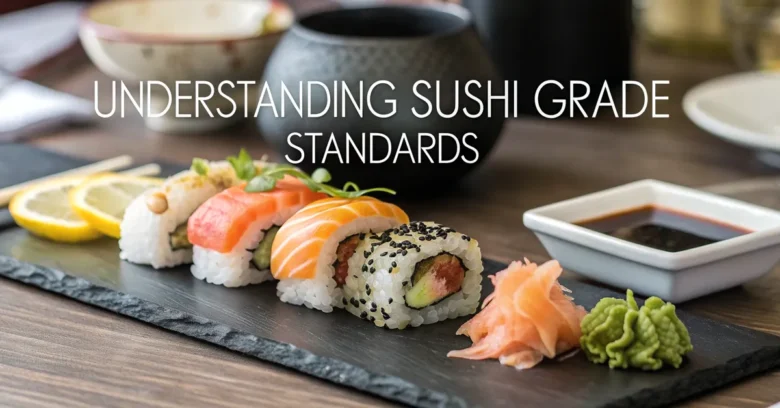Navigating the world of sushi can feel like entering another dimension, especially when phrases like “sushi grade” get thrown around. You might wonder: what does that even mean? Does it guarantee the fish is safe to eat raw? Is it just a marketing ploy? If you’re someone who cares about quality, who wants to enjoy sushi with peace of mind, then understanding this term is key.
This article will act as a guide, peeling back the layers of the “sushi grade” label. It will look into the different aspects of what makes fish suitable for raw consumption, touching on safety standards, handling practices, and what to look for when purchasing.
What “Sushi Grade” Really Means (and Doesn’t Mean)
Let’s get straight to the heart of the matter. “Sushi grade” isn’t an official, regulated term with a universal definition. No governing body dictates what qualifies a fish for this label. Instead, it’s a term that’s loosely used in the seafood industry to suggest that fish is of high enough quality and has been handled in a way that makes it safe to eat raw.
However, here’s where it gets tricky: different suppliers, distributors, and retailers might have their own interpretations of what “sushi grade” entails. What one vendor considers “sushi grade” might not meet the standards of another. This lack of standardization can be confusing and even misleading for consumers.
Think of it like the term “fresh.” While it suggests a product is recently harvested or made, there’s no strict legal definition behind it. It’s up to the seller to determine what constitutes “fresh,” which can lead to inconsistencies.
So, what does “sushi grade” not mean? It doesn’t automatically guarantee the fish is parasite-free. It doesn’t ensure it was caught in a specific location or handled in a particular way. It’s simply an indication that the seller believes the fish is suitable for raw consumption.
Why Eating Raw Fish Can Be Risky
Before we move on, let’s address the elephant in the room. Eating raw fish can pose certain health risks, primarily related to parasites and bacteria. This isn’t meant to scare you away from sushi, but to emphasize the need for caution and awareness.
Parasites: The Unseen Threat
The most common concern with raw fish is the presence of parasites. These tiny organisms can live in the flesh of fish and, if ingested, can cause a range of health problems, from mild discomfort to more serious illnesses.
Some of the parasites that can be found in fish include:
- Anisakis: This roundworm is one of the most common culprits behind parasitic infections from seafood. It can cause anisakiasis, an illness characterized by abdominal pain, nausea, vomiting, and diarrhea.
- Diphyllobothrium: This tapeworm, also known as the broad fish tapeworm, can grow to impressive lengths in the human intestine, causing abdominal discomfort, fatigue, and weight loss.
Bacterial Contamination: A Matter of Handling
Bacteria are another potential hazard associated with raw fish. Improper handling, storage, or processing can lead to bacterial growth, which can cause food poisoning.
Common bacteria found in seafood include:
- Salmonella: This bacterium is a well-known cause of food poisoning, leading to symptoms such as diarrhea, fever, abdominal cramps, and vomiting.
- Vibrio: Certain species of Vibrio bacteria can cause seafood-related illnesses, including gastroenteritis and wound infections.
Other Potential Risks
Besides parasites and bacteria, other risks associated with raw fish consumption include:
- Viruses: While less common than parasites and bacteria, viruses like norovirus and hepatitis A can sometimes contaminate seafood.
- Toxins: Certain fish species, like pufferfish, contain potent toxins that can be deadly if not properly removed.
These are the reasons why understanding sushi grade is so important. Now that we know what sushi grade is and potential risk associated with eating sushi, let’s look at what measures are taken to mitigate these risks.
The Key Safety Measures for “Sushi Grade” Fish
While the term “sushi grade” lacks formal regulation, responsible suppliers and distributors take several steps to ensure their fish is safe for raw consumption. These measures focus on minimizing the risk of parasites and bacterial contamination.
Freezing: The Parasite Killer
Freezing is one of the most effective ways to kill parasites in fish. The Food and Drug Administration (FDA) recommends specific freezing protocols for fish intended for raw consumption to render any parasites non-viable.
The FDA guidelines state that fish should be frozen using one of the following methods:
- Freezing and storing at -4°F (-20°C) or below for 7 days (168 hours)
- Freezing at -31°F (-35°C) or below until solid and storing at -31°F (-35°C) or below for 15 hours
- Freezing at -31°F (-35°C) or below until solid and storing at -4°F (-20°C) or below for 24 hours
These freezing temperatures and durations are designed to effectively kill parasites, making the fish safe for raw consumption. However, it’s important to note that freezing doesn’t eliminate bacteria or toxins.
Proper Handling and Sanitation: Preventing Bacterial Growth
Good handling and sanitation practices are crucial to prevent bacterial contamination of fish. This includes:
- Maintaining Cold Temperatures: Keeping fish at cold temperatures (below 40°F or 4.4°C) during storage and transportation inhibits bacterial growth.
- Using Clean Equipment: Ensuring that all surfaces, knives, and other equipment that come into contact with the fish are thoroughly cleaned and sanitized.
- Practicing Good Hygiene: Requiring employees to wash their hands frequently and wear clean gloves when handling fish.
- Rapid Processing: Processing the fish quickly after harvesting to minimize the time it spends at ambient temperatures.
Sourcing from Reputable Suppliers: A Chain of Trust
Choosing fish from reputable suppliers is essential for ensuring safety and quality. These suppliers should have established relationships with fishermen and processors who follow strict safety protocols.
Reputable suppliers should also be able to provide documentation about the origin of the fish, how it was handled, and whether it has been tested for parasites and bacteria. This transparency allows buyers to make informed decisions and build trust in the product.
Inspection and Testing: Verifying Safety
Some suppliers go the extra mile by conducting inspections and testing to verify the safety of their fish. This may involve:
- Visual Inspection: Examining the fish for signs of parasites or spoilage.
- Microscopic Examination: Analyzing samples of fish tissue under a microscope to detect parasites.
- Bacterial Testing: Testing for the presence of harmful bacteria like Salmonella and Vibrio.
These inspections and tests provide an extra layer of assurance that the fish is safe for raw consumption. However, it’s important to note that testing can only detect the presence of contaminants at the time of testing, so it’s not a foolproof guarantee of safety.
Decoding Fish Quality: What to Look for
Beyond safety measures, certain indicators suggest the quality and freshness of fish. Here’s what to look for when selecting fish for sushi:
Appearance: A Visual Assessment
- Eyes: The eyes should be clear, bright, and slightly bulging. Sunken or cloudy eyes are a sign of age.
- Gills: The gills should be bright red or pink and free from slime. Dull or brownish gills indicate spoilage.
- Flesh: The flesh should be firm, elastic, and have a vibrant color characteristic of the species. Soft, mushy, or discolored flesh is a red flag.
- Skin: The skin should be shiny and have a metallic sheen. Dull or slimy skin suggests the fish is not fresh.
Smell: A Nose Knows
Fresh fish should have a mild, sea-like odor. A strong, fishy, or ammonia-like smell is a sign of spoilage. Trust your nose – if something smells off, it’s best to avoid it.
Texture: A Matter of Feel
The flesh of fresh fish should be firm and spring back when touched. If it feels soft, mushy, or easily separates, it’s likely not fresh.
Source and Handling: Asking the Right Questions
Don’t hesitate to ask your fishmonger or sushi chef about the source of the fish and how it was handled. Inquire about:
- Origin: Where was the fish caught or farmed?
- Handling: How was the fish handled from the time it was caught until it reached the point of sale?
- Freezing: Was the fish frozen to kill parasites? If so, what freezing method was used?
- Testing: Has the fish been tested for parasites or bacteria?
A knowledgeable and transparent seller should be able to answer these questions confidently and provide documentation if available.
Species-Specific Considerations: Knowing Your Fish
Different fish species have different characteristics and potential risks. Understanding these differences can help you make informed choices.
- Tuna: Tuna is a popular choice for sushi and sashimi. Look for a deep red color and firm texture. Certain species, like bluefin tuna, can be prone to histamine production if not properly handled, leading to scombroid poisoning.
- Salmon: Salmon is another favorite for raw consumption. Look for a vibrant orange color and distinct marbling. Farmed salmon may have a higher risk of contaminants than wild-caught salmon.
- Yellowtail (Hamachi): Yellowtail has a buttery flavor and smooth texture. It’s important to source yellowtail from reputable suppliers, as some farms may use antibiotics or other treatments that can affect quality and safety.
- Mackerel (Saba): Mackerel has a strong, distinctive flavor. It’s prone to histamine production, so it’s important to ensure it’s very fresh.
- Freshwater Fish: Freshwater fish, like trout and perch, have a higher risk of parasites than saltwater fish. If you’re considering eating freshwater fish raw, make sure it has been properly frozen to kill parasites.
Navigating the Sushi Restaurant: Making Informed Choices
When dining at a sushi restaurant, you can take steps to ensure the fish you’re eating is safe and high-quality.
Choose Reputable Establishments: A Track Record of Quality
Opt for sushi restaurants with a good reputation and positive reviews. Look for restaurants that:
- Have a clean and well-maintained environment.
- Employ experienced and knowledgeable sushi chefs.
- Source their fish from reputable suppliers.
- Follow proper food safety practices.
Ask Questions: Don’t Be Shy
Don’t hesitate to ask the sushi chef or server about the fish you’re ordering. Inquire about:
- Origin: Where did the fish come from?
- Freshness: How fresh is the fish?
- Handling: How was the fish handled and stored?
- Preparation: How is the sushi prepared to ensure safety?
A good sushi restaurant will be transparent about their practices and happy to answer your questions.
Trust Your Senses: Look, Smell, and Taste
Pay attention to the appearance, smell, and taste of the sushi. If anything seems off, don’t eat it. A reputable sushi restaurant will be understanding and offer a replacement.
Consider Cooked Options: A Safe Alternative
If you’re concerned about the risks of eating raw fish, consider ordering cooked sushi options. Many delicious cooked sushi rolls are available, such as tempura rolls, California rolls, and eel rolls.
Buying “Sushi Grade” Fish for Home Preparation: A DIY Approach
If you’re feeling adventurous and want to prepare sushi at home, you can purchase “sushi grade” fish from reputable fishmongers or online retailers.
Find a Reputable Fishmonger: Your Trusted Source
Look for a fishmonger who:
- Has a wide selection of fresh fish.
- Knows their products and can answer your questions.
- Follows proper food safety practices.
- Is transparent about the origin and handling of their fish.
Inquire About “Sushi Grade”: Asking the Key Question
When purchasing fish for sushi, specifically ask if it’s “sushi grade” or suitable for raw consumption. A reputable fishmonger will be able to advise you on which species are safe and how to handle them properly.
Follow Safe Handling Practices: Your Responsibility
If you’re purchasing fish from a fishmonger, be sure to ask if the fish has already been frozen, and what procedure was used. If not, it’s important to follow safe handling practices:
- Keep it Cold: Keep the fish refrigerated at all times, and transport it in a cooler with ice packs.
- Use Clean Equipment: Use clean knives and cutting boards when preparing the fish.
- Wash Your Hands: Wash your hands thoroughly before and after handling the fish.
- Consume Promptly: Prepare and consume the sushi as soon as possible after purchasing the fish.
- Freeze if Necessary: If you are unsure, or plan on consuming it days after purchasing, it’s always wise to follow FDA guidelines and freeze the fish at sub-zero temperatures to rid it of parasites.
Understanding the Risks: Being Informed
It’s important to be aware of the risks associated with eating raw fish and to take precautions to minimize those risks. If you have any concerns about your health or food safety, consult with a doctor or food safety expert.
Debunking Common Myths About “Sushi Grade” Fish
Several misconceptions surround the term “sushi grade.” Let’s clear up some of the most common myths:
- Myth: “Sushi grade” fish is always parasite-free.
- Fact: While “sushi grade” fish has been handled to minimize the risk of parasites, it’s not a guarantee. Freezing is the most effective way to kill parasites, but not all “sushi grade” fish has been frozen.
- Myth: “Sushi grade” fish is always the freshest fish.
- Fact: While freshness is important, “sushi grade” refers more to how the fish was handled and processed than its age. Fish that has been properly frozen and thawed can still be “sushi grade” even if it’s not the absolute freshest.
- Myth: All fish sold at sushi restaurants is “sushi grade.”
- Fact: Not all sushi restaurants use “sushi grade” fish. Some may use lower-quality fish for cooked dishes or rely on other methods to ensure safety.
- Myth: “Sushi grade” fish is more expensive.
- Fact: While “sushi grade” fish may sometimes be more expensive due to the extra handling and quality control measures, it’s not always the case. Prices can vary depending on the species, source, and retailer.
- Myth: “Sushi grade” fish guarantees no health problems.
- Fact: Though suppliers that adhere to strict safety protocols will minimize the risk of parasitic and bacterial infection, eating “sushi grade” fish does not guarantee that a person will not encounter health problems.
Enjoying Sushi Safely and Confidently
Understanding the term “sushi grade” is a step in the right direction when it comes to consuming sushi safely. Always remember that due diligence, and relying on your own instincts are most important in this process. If you’re unsure of a fish source, don’t be afraid to ask questions.
When you use what you’ve learned in this article, you can enjoy sushi with added peace of mind, appreciating its flavor without worry.



